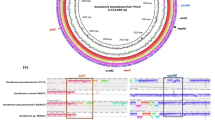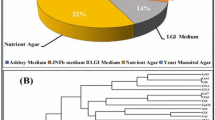Abstract
The aim of this study was to use several approaches to assess the diversity occuring in a collection of rhizobial strains that had been isolated from Gliricidia sepium (Jacq.) Walp. originating from Kenya, Reunion Island and New Caledonia. Results showed that G. sepium establishes an effective symbiosis only with fast-growing rhizobia. This suggests that this legume nodulates preferentially with this type of rhizobia, although ineffective nodules were observed on root systems of plants inoculated with slow-growing rhizobia. It was possible to distinguish several groups of strains which have the same behaviour in terms of utilization of amino acids and sources of carbon and intrinsic resistance to antibiotics and salinity. Six molecular groups were distinguished by profiles obtained using PCR/RFLP techniques. No relationship was demonstrated between phenotypic groups and molecular groups. Neither was it possible to find a relationship between the geographic origins of the strains and their distribution in the several phenotypic and/or molecular groups. In an experiment carried out under glasshouse conditions, we observed that all strains from the collection significantly improved the growth of G. sepium cultivated in a substrate totally devoid of nitrogen. The strain GsK5 induced the greatest stimulation of plant growth.
Similar content being viewed by others
References
André, S., Neyra, M. & Duponnois, R. 2003 Arbuscular mycorrhizal symbiosis changes the colonization pattern of Acacia tortillis spp. raddiana rhizosphere by two strains of rhizobia. Microbial Ecology 45, 137–144.
Awonaike, K. O., Danso, S. K. A. & Zapata, F. 1992 Biological Nitrogen Fixation by Gliricidia sepium and Acacia senegal in association with Rhizobium and Bradyrhizobium strains. Nitrogen Fixing Trees Research Reports 10, 36–39.
Berraho, E. B., Lesueur, D., Diem, H. G. & Sasson, A. 1997 Iron requirement and siderophore production in Rhizobium ciceri during growth on a iron-deficient medium. World Journal of Microbiology and Biotechnology 13, 501–511.
Bremner, J. M. & Mulvaney, C. S. 1982 Nitrogen-total. In Methods of Soil Analysis, Part. 2, eds. Page A. L. Madison, Wisconsin, USA: American Society of Agronomy, ISBN 0–89118072-9.
Broughton, W. J. & Dilworth, M. J. 1971 Control of leghaemoglobin synthesis in snake beans. Biochemical Journal 125, 1075–1080.
Castro, S., Permigiani, M., Vinocur, M. & Fabra, A. 1999 Nodulation in peanut (Arachis hypogae L. ) roots in the presence of native and inoculated rhizobia strains. Applied Soil Ecology 13, 39–44.
Danso, S. K. A., Bowen, G. D. & Sanginga, N. 1992 Biological nitrogen fixation in trees in agro-ecosystems. Plant and Soil 141, 177–196.
De Lajudie, P., Willems, A., Pot, B., Dewettinck, D., Maestrojuan, G., Neyra, M., Collins, M. D., Dreyfus, B., Kersters, K. & Gillis, M. 1994 Polyphasic taxonomy of rhizobia: emendation of the genus Sinorhizobium and description of Sinorhizobium meliloti comb. nov., Sinorhizobium saheli sp. nov., and Sinorhizobium teranga sp. nov. International Journal of Systematic Bacteriology 44, 715–733.
Diagne, O. 1988. Rhizobium en symbiose avec Prosopis Juliflora (Swartz) DC: Caracté risation et interaction avec la microflore antagoniste du sol. Ph. D. Thesis. University of Lyon, France.
Dommergues, Y. R. 1995 Nitrogen fixation by trees in relation to soil nitrogen economy. Fertilizer Research 42, 215–230.
Dommergues, Y. R., Duhoux, E. & Diem, H. G. 1998 Les arbres fixateurs d'azote. Editions Espace 34, Editions Scientifiques et Culturelles. ISBN 2–907293-57-5.
Galiana, A. 1990. La symbiose fixatrice d'azote chez Acacia mangiumrhizobium. Ph. D. Thesis, University of Paris VI, France.
Gutteridge, R. C. & Shelton, H. M. 1994 Forage tree legumes in tropical agriculture. CAB International, Wallingford, U. K. ISBN 0–85198-868-7
Halliday, J. & Somasegaran, P. 1983 Nodulation, nitrogen fixation, and Rhizobium strains affinities in the genus. In Leucaena Research in the Asian-Pacific Region: Proceedings of a Workshop held in Singapore, pp. 27–32. Ottawa: Nitrogen Fixing Tree Association & International Development Research Centre, ISBN 0–88936372-2.
Halliday, J. & Somasegaran, P. 1984 The rhizobium germplasm resource at NifTAL. Catalogue of strains. University of Hawaii, USA.
Lesueur, D., Tassin, J., Enilorac, MP., Sarrailh, JM. & Peltier, R. 1996 Study of the Calliandra calothyrsus– Rhizobium nitrogen fixing symbiosis. In Forest; Farm and Community Tree Research Reports, Special issue for the International Workshop on the genus Calliandra held at Bogor; Indonesia, Evans D. O., ed. pp. 62–76. Morrilton, USA: Winrock International Institute for Agricultural Development.
Lesueur, D., Ingleby, K., Odee, D., Chamberlain, J., Wilson, J., Tiki Manga, T., Sarrailh, J. M. & Pottinger, A. 2001 Improvement of forage production in Calliandra calothyrsus: Methodology for the identification of an effective inoculum containing Rhizobium strains and arbuscular mycorrhizal isolates. Journal of Biotechnology 91, 269–282.
Lindström, K. & Lehtomäki, S. 1988 Metabolic properties, maximum growth temperature and phage sensitivity of Rhizobium spp. (Galega) compared with other fast-growing rhizobia. FEMS Microbiology Letters 50, 277–287.
Moreira, F. M. S., Gillis, M., Pot, B., Kersters, K. & Franco, A. A. 1993 Characterisation of rhizobia isolated from differents divergence groups of tropical Leguminosae by comparative polacrylamide gel electrophoresis of their total proteins. Systematic and Applied Microbiology 16, 135–146.
Navarro, E., Simonet, P., Normand, P. & Bardin, R. 1992 Characterization of natural population of Nitrobacter spp. using PCR/ RFLP analysis of ribosomal intergenic spacer. Archives of Microbiology 157, 107–115.
Ndiaye, M. & Ganry, F. 1997 Variation in the biological N2 fixation by tree legumes in three ecological zones from the North to the South of Senegal. Arid Soil Research and Rehabilitation 11, 245–254.
Ponsonnet, C. & Nesme, X. 1994 Identification of Agrobacterium strains by PCR-RFLP analysis of pTi and chromosomal regions. Archives of Microbiology 161, 300–309.
Sanginga, N., Manrique, K. & Hardarson, G. 1991 Variation in nodulation and nitrogen fixation by the Gliricidia sepium/Rhizobium spp. symbiosis in a calcareous soil. Biology and Fertility of Soils 11, 273–278.
Schwyn, B. & Neilands, J. B. 1987 Universal chemical assay for the detection and determination of siderophores. Analytical Biochemistry 160, 47–56.
Turk, D. & Keyser, H. H. 1992 Rhizobia that nodulate tree legumes: specificity of the host for nodulation and effectiveness. Canadian Journal of Microbiology 38, 451–460.
Vincent, J. M. 1970 A Manual for the Practical Study of Root-nodule bacteria. International Biological Programme. Handbook No. 15, Blackwell, Oxford, U. K. ISBN 0–63206410-2.
Author information
Authors and Affiliations
Rights and permissions
About this article
Cite this article
Thiao, M., Neyra, M., Isidore, E. et al. Diversity and effectiveness of rhizobial strains from Gliricidia sepium native to Reunion Island, Kenya and New Caledonia. World Journal of Microbiology and Biotechnology 20, 703–709 (2004). https://doi.org/10.1007/s11274-004-2562-0
Issue Date:
DOI: https://doi.org/10.1007/s11274-004-2562-0




